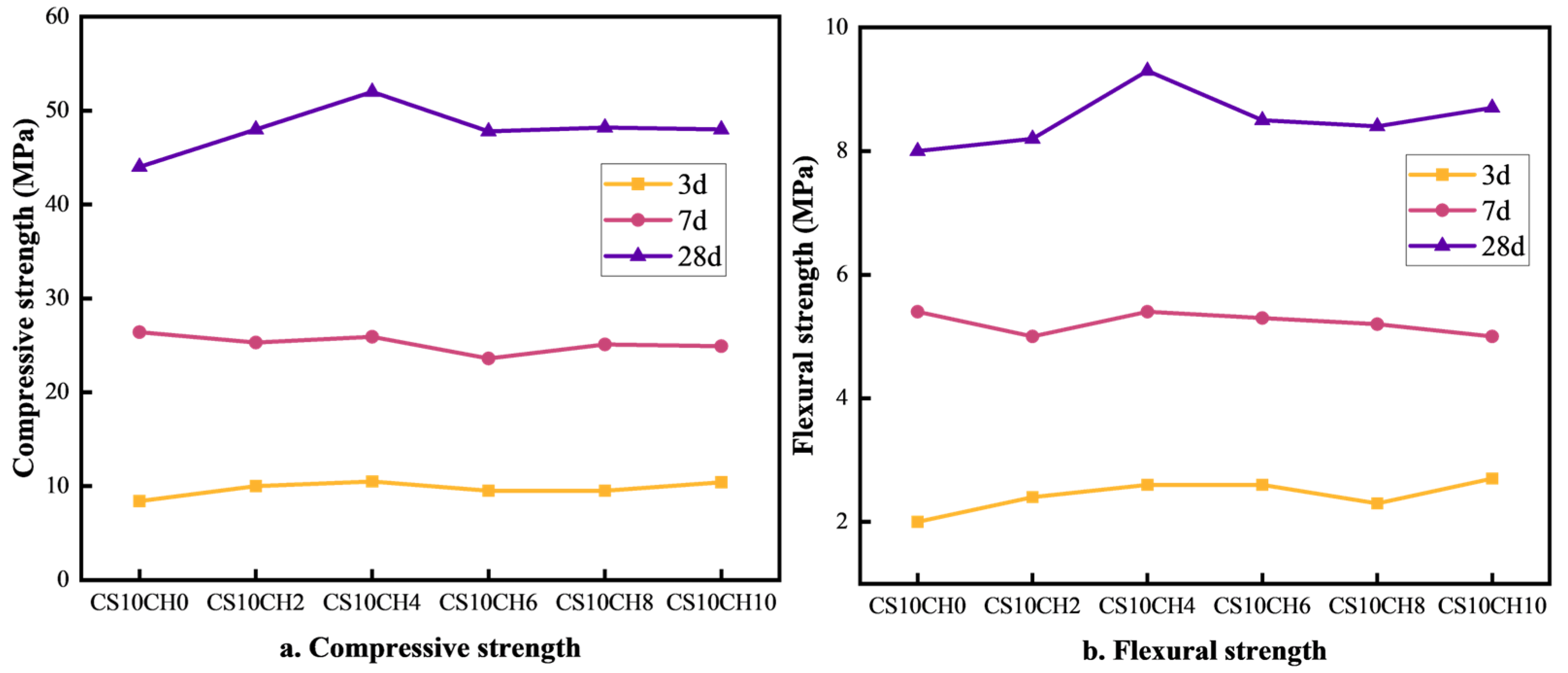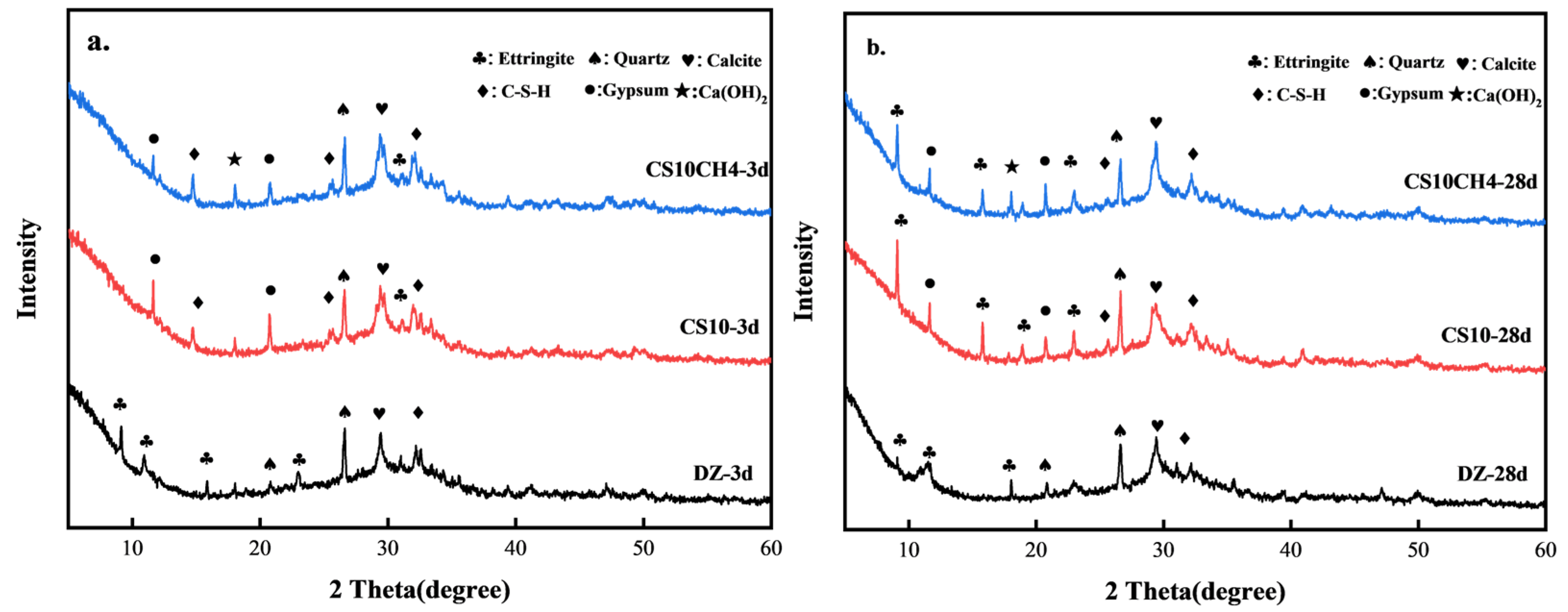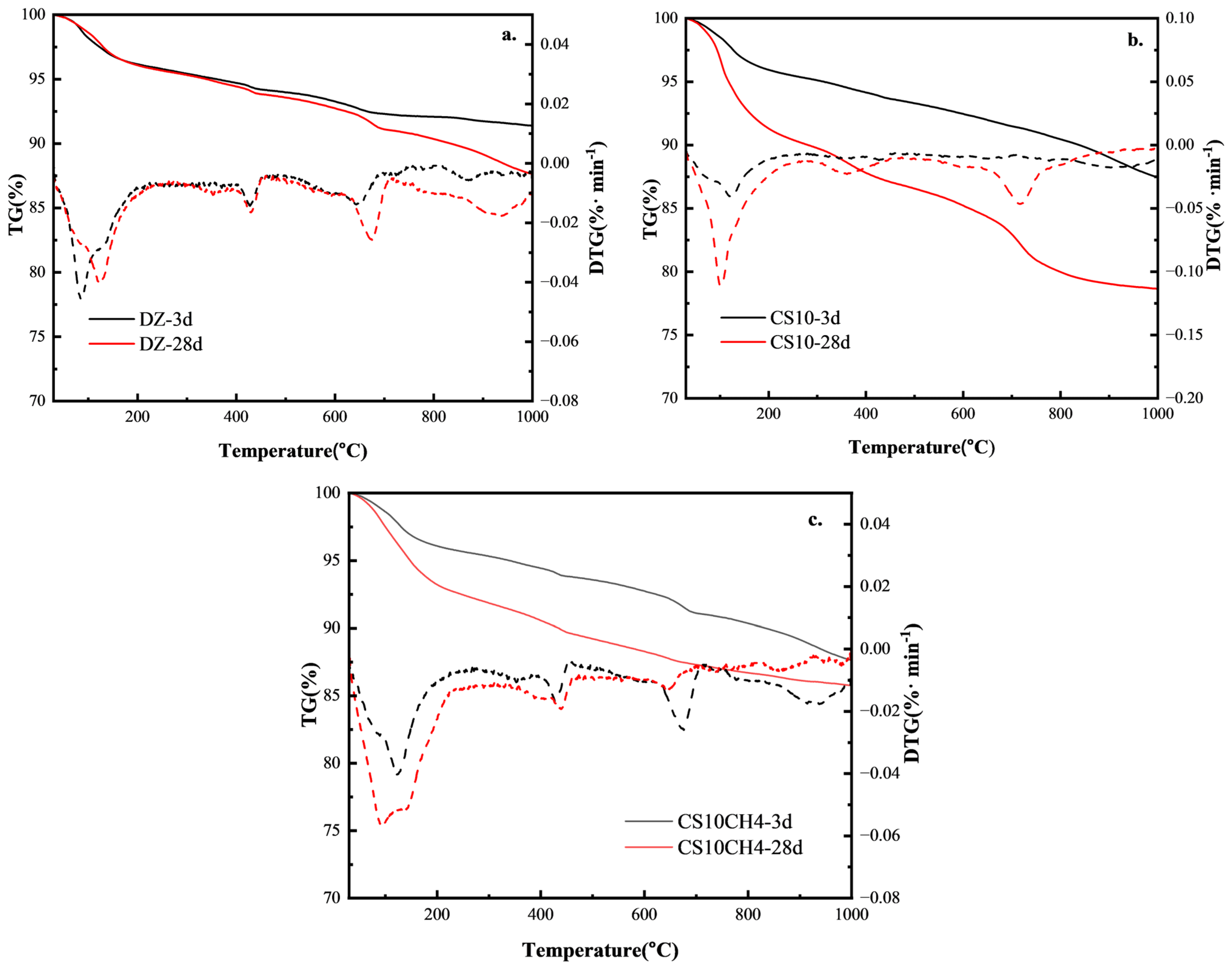A Study on the Influence of Gypsum and Ca(OH)2 on the Mechanical Properties and Hydration Behavior of Multi-Component Solid Waste-Based Cementitious Materials
Abstract
1. Introduction
2. Test
2.1. Test Raw Materials
2.2. Test Methods
2.2.1. Mechanical Performance Test
2.2.2. XRD
2.2.3. FTIR
2.2.4. TG-DTG
2.2.5. SEM
3. Result and Discussion
3.1. Effect of Gypsum on Strength of Multiple Solid Waste Cementitious Materials
3.2. The Effect of Gypsum Mixed with Calcium Hydroxide on the Strength of Multi-Component Solid Waste Cementitious Materials
3.3. XRD Analysis
3.4. FTIR Analysis
3.5. TG-DTG Analysis
3.6. SEM Analysis
4. Conclusions
- (1).
- The optimal dosage of gypsum in the multifunctional solid waste-based cementitious system was determined to be 10%, at which the compressive strengths at 3, 7, and 28 days reached 8.4 MPa, 26.4 MPa, and 44.0 MPa, respectively. This dosage notably contributed to the enhancement of the later-age strength. Compared with single-gypsum activation, the synergistic activation using a combination of gypsum and calcium hydroxide (Ca(OH)2) proved more effective in improving compressive strength. In the CS10CH4 group, the compressive strengths at 3, 7, and 28 days were recorded as 10.5 MPa, 25.9 MPa, and 52.0 MPa, respectively, indicating a significant improvement, particularly in long-term strength development.
- (2).
- The CS10CH4 group exhibited the highest degree of hydration and the greatest formation of C-S-H gels, which significantly contributed to strength development. This improvement is primarily attributed to the additional calcium hydroxide, which enhanced the alkalinity of the system, thereby promoting pozzolanic reactions and increasing the yield of hydration products. Moreover, the elevated alkalinity accelerated the formation of ettringite (AFt), further enhancing the material’s performance. Overall, the combined activation using gypsum and calcium hydroxide effectively facilitated the hydration process of multifunctional solid waste-based cementitious materials, leading to improved mechanical properties and enhanced structural stability.
- (3).
- With the global emphasis on sustainable development and environmental protection, multifunctional solid waste gelling materials are poised to gain new development opportunities. Future research can further explore the synergistic use of gypsum and calcium hydroxide (Ca(OH)2) with other activators to optimize the performance of multi-component solid waste cementitious systems. Additionally, integrating big data and artificial intelligence technologies to establish predictive models for material performance can provide a scientific foundation for the optimized design of these materials. Strengthening application-focused research in real-world engineering projects will also be crucial in promoting the large-scale adoption and implementation of such sustainable materials.
Author Contributions
Funding
Institutional Review Board Statement
Informed Consent Statement
Data Availability Statement
Conflicts of Interest
References
- Zheng, C.; Zhang, H.; Cai, X.; Chen, L.; Liu, M.; Lin, H.; Wang, X. Characteristics of CO2 and atmospheric pollutant emissions from China’s cement industry: A life-cycle perspective. J. Clean. Prod. 2020, 282, 124533. [Google Scholar] [CrossRef]
- Luukkonen, T.; Abdollahnejad, Z.; Yliniemi, J.; Kinnunen, P.; Illikainen, M. One-part alkali-activated materials: A review. Cem. Concr. Res. 2018, 103, 21–34. [Google Scholar] [CrossRef]
- Shi, C.; Jiménez, A.F.; Palomo, A. New cements for the 21st century: The pursuit of an alternative to Portland cement. Cem. Concr. Res. 2011, 41, 750–763. [Google Scholar] [CrossRef]
- Zhang, Y.; Li, S.; Chen, B. Experimental study on active exciter of fly ash. Concrete 2012, 9, 63–64+68. (In Chinese) [Google Scholar]
- Provis, J.L.; Palomo, A.; Shi, C. Advances in understanding alkali-activated materials. Cem. Concr. Res. 2015, 78, 110–125. [Google Scholar] [CrossRef]
- Namarak, C.; Satching, P.; Tangchirapat, W.; Jaturapitakkul, C. Improving the compressive strength of mortar from a binder of fly ash-calcium carbide residue. Constr. Build. Mater. 2017, 147, 713–719. [Google Scholar] [CrossRef]
- Li, W.; Yi, Y. Use of carbide slag from acetylene industry for activation of ground granulated blast-furnace slag. Constr. Build. Mater. 2020, 238, 117713. [Google Scholar] [CrossRef]
- Zhang, Y. Research on the Properties of One-Component Alkali-Excited Slag-Fly Ash Mortar. Master’s Thesis, Anhui University of Technology, Maanshan, China, 2024; p. 001615. (In Chinese). [Google Scholar]
- Na, S.; Zhang, W.; Ichikawa, Y. Fundamental Study on Alkali-Activated Slag System with Sodium Carbonate or Calcium Hydroxide. J. Mater. Sci. Chem. Eng. 2024, 12, 55–70. [Google Scholar]
- Chen, H.; Dai, H.; Jia, Z. Effects of fly ash and mineral powder on deformation properties of cement paste. Cem. Concr. Res. 2021, 4, 28–31. [Google Scholar]
- Zheng, J.; Bi, P.; Li, S.; Yang, Z. Effects of NaOH and gypsum contents on the properties of cemented paste backfill using NaOH/gypsum-activated slag binders. Constr. Build. Mater. 2025, 470, 140552. [Google Scholar] [CrossRef]
- Hadi, B.; Hasan, M.; Bahman, G.; Davood, M. A comparative study of calcium hydroxide, calcium oxide, calcined dolomite, and metasilicate as activators for slag-based HPC. Structures 2023, 58, 105653. [Google Scholar]
- Yunpeng, Q.; Qiusheng, W.; Hao, L.; He, P. Effects of calcium sulfate as activator on mechanical properties of PVA fiber reinforced cementitious composites with high-volume fly ash. Powder Technol. 2023, 430, 118965. [Google Scholar]
- Song, Y.; Qiao, H.; Feng, Q.; Wei, C.; Zheng, J.; Qiao, H. Feasibility study of adding alkali activator Ca(OH)2 into ferrous extraction tailing of nickel slag-ordinary Portland cement composite cementitious system: Working performance, mechanical properties, and reaction mechanism. Adv. Cem. Res. 2024, 37, 172–185. [Google Scholar] [CrossRef]
- Liang, Z.; Biao, H.; Qi, S. Preparation and hydration properties of gypsum slag-based multi-component solid waste low-carbon cementitious materials. Non-Ferr. Met. (Smelt. Compon.) 2024, 9, 154–163. (In Chinese) [Google Scholar]
- Ni, Z.; Xue, L.; Ding, Y. Effect of desulfurized gypsum on properties and microstructure of alkali-activated cementitious materials. Silic. Bull. 2024, 43, 2933–2940+2951. (In Chinese) [Google Scholar]
- Li, L.; Darquennes, A.; Hannawi, K.; Che, C. Effect of the Alkali-Sulphate Activators on the Hydration Process of Blast-Furnace Slag Mortars and Pastes. Materials 2025, 18, 514. [Google Scholar] [CrossRef]
- Valentino, M.; Leonardo, M.; Daniela, G.; Enrico, B. Investigating the hydration of C3A in the combined presence of anhydrite and limestone using solid-state NMR, XRD and TG techniques. Constr. Build. Mater. 2023, 378, 131028. [Google Scholar]
- Yang, L. Study on the properties of alkali-activated cementitious materials prepared by synergistic activation of calcium hydroxide and sodium sulfate. Heilongjiang Sci. Technol. Water Conserv. 2024, 52, 23–26. [Google Scholar]
- Wang, Y. Microstructure Evolution and Composite Synergistic Effect of Red Mud-Fly Ash-Desulfurization Gypsum New Cementitious Material. Ph.D. Dissertation, Beijing University of Science and Technology, Beijing, China, 2022. (In Chinese). [Google Scholar]
- Zhang, Y.; Chen, X.; Zhou, J.; Wang, Q.; Liu, Z.; Ma, Z.; Huang, J. Meso-scale damage characteristics of low carbon concrete with recycled aggregate based on in-situ CT test. Constr. Build. Mater. 2023, 365, 130014. [Google Scholar] [CrossRef]
- Liu, Q.; He, Q.; Li, R.; Feng, Y.; Lyu, X.; Wang, J.; Li, L. Influence of colloidal nanosilica on hydration kinetics and properties of CaO/CaSO4-activated slag binder. Int. J. Min. Sci. Technol. 2022, 32, 1407–1418. [Google Scholar] [CrossRef]
- Zhang, B. Preparation and properties of slag-fly ash geopolymer cementitious materials. Shandong Chem. Ind. 2023, 52, 46–48+53. (In Chinese) [Google Scholar]
- GB/T 17671-2021; Cement Mortar Strength Test Method. China Construction Industry Press: Beijing, China, 2021.
- Kong, Z.; Dai, M.; Zhao, M. Experimental study on mechanical properties of one-component alkali slag mortar. Concrete 2024, 11, 134–137+154. (In Chinese) [Google Scholar]
- Chen, H. Research on the Excitation Effect and Mechanism of Natural Hard Gypsum and Its Composite Exciter on Mineral Admixture. Master’s Thesis, Xi’an University of Architecture and Technology, Xi’an, China, 2023; p. 001491. [Google Scholar]
- Kong, D.; Zhang, S.; Zhang, J.; Liu, T.; Wang, L.; Jin, L. Enhancing carbonation resistance of low-activity coal gangue-based LC3 cementitious materials with Ca(OH)2 and gypsum additives. J. Build. Eng. 2024, 98, 111275. [Google Scholar] [CrossRef]
- Cheng, F.; Xia, J. Effect of composite exciter on the properties of gangue cementitious materials. New Chem. Mater. 2024, 52, 186–191. (In Chinese) [Google Scholar]
- Wang, J. Mechanisms of the Effect of Organic Admixtures on the Synthesis of Chalcocite, Calcium Hydroxide and C-S-H. Master’s Thesis, Tsinghua University, Beijing, China, 2021; p. 000277. (In Chinese). [Google Scholar]
- Arnavutoglu, E.; Arbag, H.; Koyuncu, E.D.D. Change in Microstructure, Mechanical Strength, Fire Resistance, and Radiation Attenuation Properties of Gypsum Plaster with Boric Acid. Arab. J. Sci. Eng. 2024. prepublish. [Google Scholar] [CrossRef]
- Zhan, J.; Li, H.; Fu, B.; Tuo, M. Effects of different alkali equivalents, fly ash and slag dosage on mechanical properties and microstructure of alkali-excited fly ash-slag geopolymers. Sci. Technol. Eng. 2021, 21, 12218–12224. (In Chinese) [Google Scholar]
- Wang, X.; Lv, J.; Yang, J.; Zhu, J. Synergistic effects of ground granulated blast furnace slag and circulating fluidized bed fly ash in lime-activated cementitious materials. Case Stud. Constr. Mater. 2025, 22, e04259. [Google Scholar] [CrossRef]
- Yang, D. Study on the Properties and Hydration Mechanism of Alkali-Excited Slag/Fly Ash Cementitious Materials. Master’s Thesis, Shandong Institute of Transportation, Jinan, China, 2022; p. 000079. (In Chinese). [Google Scholar]
- Yuan, X.; Zhao, H. Improvement of activity and mechanism of steel slag cementitious materials by different excitation methods. Sinter Pellets 2024, 49, 107–113. (In Chinese) [Google Scholar]
- Sun, Y.; Duan, S.; Zhang, H. Effects of chemical admixtures on the properties and hydration behavior of solid waste-based cementitious materials. Adv. Chem. Eng. 2025, 44, 1739–1748. (In Chinese) [Google Scholar]
- Chang, N.; Li, H.; Liu, W. Mechanical strength, hydration products, and microstructure of waste-derived composite-activated cementitious materials by varying titanium gypsum phase composition. Constr. Build. Mater. 2024, 456, 139328. [Google Scholar] [CrossRef]
- Liu, G.; Ding, M.; Liu, J. Hydration behavior and mechanical properties of alkali excited mineral powder-fly ash-metakaolin geopolymer. Silic. Bull. 2023, 42, 2106–2114. (In Chinese) [Google Scholar]






| Name | CaO | SiO2 | Al2O3 | SO3 | MgO | Fe2O3 | TiO2 | K2O | Na2O |
|---|---|---|---|---|---|---|---|---|---|
| Cement | 63.82 | 22.18 | 4.46 | 2.55 | 2.42 | 3.22 | 0.82 | 0.04 | 0.51 |
| Slag | 39.30 | 34.53 | 12.73 | 0.40 | 8.27 | 1.93 | 0.90 | 0.80 | 0.30 |
| Flyash | 4.80 | 56.20 | 26.01 | 1.02 | 1.56 | 5.09 | 1.80 | 0.90 | 0.29 |
| Silica fume | 0.29 | 87.50 | 2.15 | 0.52 | 3.86 | 0.70 | 1.11 | 3.31 | 0.56 |
| No | Gypsum | Water | Slag | Flyash | Silica Fume | Cement | Sand |
|---|---|---|---|---|---|---|---|
| DZ | 0 | 225 | 242.55 | 103.95 | 13.5 | 90 | 1350 |
| CS4 | 18 | 221.4 | |||||
| CS6 | 27 | 219.6 | |||||
| CS8 | 36 | 217.8 | |||||
| CS10 | 45 | 216 |
| No | Ca(OH)2 | Gypsum | Slag | Flyash | Cement | Silica Fume | Water | Sand |
|---|---|---|---|---|---|---|---|---|
| CS10CH0 | 0 | 45 | 242.55 | 103.95 | 90 | 13.5 | 216 | 1350 |
| CS10CH2 | 9 | |||||||
| CS10CH4 | 18 | |||||||
| CS10CH6 | 27 | |||||||
| CS10CH8 | 36 | |||||||
| CS10CH10 | 45 |
Disclaimer/Publisher’s Note: The statements, opinions and data contained in all publications are solely those of the individual author(s) and contributor(s) and not of MDPI and/or the editor(s). MDPI and/or the editor(s) disclaim responsibility for any injury to people or property resulting from any ideas, methods, instructions or products referred to in the content. |
© 2025 by the authors. Licensee MDPI, Basel, Switzerland. This article is an open access article distributed under the terms and conditions of the Creative Commons Attribution (CC BY) license (https://creativecommons.org/licenses/by/4.0/).
Share and Cite
Gou, J.; Li, S.; Jiang, C.; Li, Z.; You, G. A Study on the Influence of Gypsum and Ca(OH)2 on the Mechanical Properties and Hydration Behavior of Multi-Component Solid Waste-Based Cementitious Materials. Materials 2025, 18, 1964. https://doi.org/10.3390/ma18091964
Gou J, Li S, Jiang C, Li Z, You G. A Study on the Influence of Gypsum and Ca(OH)2 on the Mechanical Properties and Hydration Behavior of Multi-Component Solid Waste-Based Cementitious Materials. Materials. 2025; 18(9):1964. https://doi.org/10.3390/ma18091964
Chicago/Turabian StyleGou, Jiansheng, Shuangxi Li, Chunmeng Jiang, Zhantao Li, and Guanglang You. 2025. "A Study on the Influence of Gypsum and Ca(OH)2 on the Mechanical Properties and Hydration Behavior of Multi-Component Solid Waste-Based Cementitious Materials" Materials 18, no. 9: 1964. https://doi.org/10.3390/ma18091964
APA StyleGou, J., Li, S., Jiang, C., Li, Z., & You, G. (2025). A Study on the Influence of Gypsum and Ca(OH)2 on the Mechanical Properties and Hydration Behavior of Multi-Component Solid Waste-Based Cementitious Materials. Materials, 18(9), 1964. https://doi.org/10.3390/ma18091964






